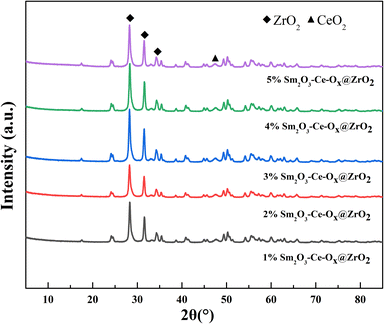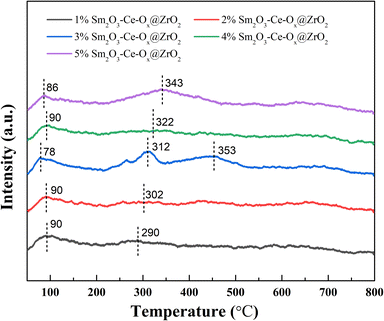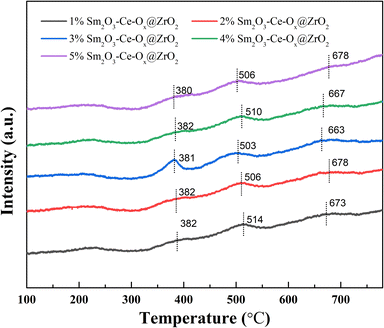 Open Access Article
Open Access ArticleCatalytic hydrolysis of carbonyl sulfide in blast furnace gas over Sm-Ce-Ox@ZrO2 catalyst†
Jintao Yu‡
ac,
Yao Lu‡ac,
Sheng Wangb,
Mutao Xuae,
Qijie Jinae,
Chengzhang Zhua,
Jisai Chen*d and
Haitao Xu *ae
*ae
aSchool of Environmental Science and Engineering, Nanjing Tech University, Nanjing 210009, PR China. E-mail: htxu@njtech.edu.cn
bState Key Laboratory for Clean and Efficient Coal-fired Power Generation and Pollution Control, State Key Laboratory of Low-carbon Smart Coal-fired Power Generation and Ultra-clean Emission, Nanjing 210046, China
cShanghai Institute of Chemical Industry Environmental Engineering Co. Ltd, Shanghai 200333, PR China
dCCSC Nanjing Luzhou Environment Protection Co., Nanjing 211100, PR China
eNanjing Gekof Institute of Environmental Protection Technology & Equipment Co. Ltd, Nanjing 210031, PR China
First published on 19th January 2024
Abstract
Carbonyl sulfur (COS) is a prominent organic sulfur pollutant commonly found in the by-product gas generated by the steel industry. A series of Sm-doped CeOx@ZrO2 catalysts were prepared for the hydrolysis catalytic removal of COS. The results showed that the addition of Sm resulted in the most significant enhancement of hydrolysis catalytic activity. The 3% Sm2O3-Ce-Ox@ZrO2 catalyst exhibited the highest activity, achieving a hydrolysis catalytic efficiency of 100% and H2S selectivity of 100% within the temperature range of 90–180 °C. The inclusion of Sm had the effect of reducing the acidity of the catalyst while increasing weak basic sites, which facilitated the adsorption and activation of COS molecules at low temperatures. Appropriate doping of Sm proved beneficial in converting active surface chemisorbed oxygen into lattice oxygen, thereby decreasing the oxidation of intermediate products and maintaining the stability of the hydrolysis reaction.
1. Introduction
Carbonyl sulfide (COS) is widely present in the by-product gas (blast furnace gas, coke oven gas, converter gas) of the iron and steel industry.1–3 Its acidity and polarity are weaker than H2S, but its properties are more stable, making the removal of COS an important part of achieving gas fine desulfurization.4,5 COS removal methods mainly include pyrolysis, hydrogenation, hydrolysis, chemical absorption and so on.6,7 Pyrolysis is greatly affected by temperature, so the hydrogenation conversion method is widely used in industry, but the hydrogenation method requires higher temperature, and is prone to side reactions.8–10 The catalytic hydrolysis method has high conversion efficiency and few side reactions. It is a hot research field at present and the core aspect is the research and development of hydrolysis catalysts.11,12COS hydrolysis catalyst are based on γ-Al2O3, TiO2, ZrO2, etc.13–16 The H2S produced by hydrolysis is easily oxidised to monosulfur or further oxidised to sulphate, which is deposited on the surface of the catalyst, thus clogging up the holes of the catalyst.17,18 γ-Al2O3 is strongly acidic, which reduces the surface alkalinity of aluminium-based catalysts, making the catalysts inadequate in low-temperature hydrolysis performance and stability.19 In contrast, TiO2 has stronger resistance to sulfate, and TiO2 itself has better catalytic hydrolysis ability for COS, but the relatively small specific surface area of TiO2 will limit its application to some extent.20,21 Studies have shown that ZrO2 has higher hydrolysis catalytic activity and stability than Al2O3 and TiO2. Previous studies found that the hydrolysis activity of nano-TiO2 and ZrO2 is much higher than that of commercial nano-Al2O3, and that the increase in the activity is due to the decrease in surface hydrophilicity of the catalyst and increase in free surface basic hydroxyl groups.22–24 However, the low-temperature hydrolysis activity of ZrO2 was insufficient, and the loaded metal oxides were proved to be effective in enhancing the hydrolysis activity of the catalysts.25,26 Consequently, the catalyst for the hydrolysis catalytic removal of carbonyl sulfur should be bifunctional, which means catalyst should have both ox-red and acid–base sites. Moreover, acid sites should be medium strength. One of the ways of such type catalyst's design is based on the application of oxide composites.
Alkali metals and alkaline earth metals regulate the alkali content and alkali strength distribution on the catalyst surface, but they do so in slightly different ways.27,28 Alkali metals have a significant modulating effect on alkali content, while alkaline earth metals have a significant modulating effect on alkali strength. Rare earth elements such as La, Ce and Pr, which have a unique 4f electron layer structure, are used as excellent catalytic materials and co-catalysts, and they exhibit unique catalytic properties in chemical reactions. When they are used in combination with components such as metals or their oxides, they have obvious synergistic effects and show reaction activities that far exceed the expected ones.29–32
Consequently, this study utilized CeO2 as the primary active component of the catalyst and ZrO2 as the catalyst carrier. The aim was to evaluate various metal oxides (Sm, Y, Na, K) for doping modification. After screening the optimal metal oxides for doping, the doping amount was adjusted to determine the most effective ratio. The morphology and structure of the catalyst were characterized, and the reasons behind the improvement in hydrolysis catalytic efficiency and anti-poisoning ability were analyzed. Additionally, the preparation conditions and process parameters of the catalyst were investigated to determine the optimal ones.
2. Experimental
2.1 Catalyst preparation
In this experiment, a specific quantity of nano-ZrO2 and Ce(NO3)3·6H2O was carefully measured and placed in a beaker. Deionised water was then added to the mixture, followed by a certain amount of Sm2(NO3)3·6H2O, Y(NO3)3, Na2CO3, and K2CO3, with a doping concentration of 1%. The mixture was stirred at a temperature of 80 °C for a duration of 8 h. The dried solid product was removed by spatula into a quartz crucible. Subsequently, the solid material was calcined in an air atmosphere at 600 °C for a period of 2 h, resulting in the formation of catalyst samples. These catalysts were given the names Sm-CeOx@ZrO2, Y-CeOx@ZrO2, Na-CeOx@ZrO2, and K-CeOx@ZrO2, respectively. Furthermore, additional catalyst samples were prepared by adjusting the amount of Sm2(NO3)3·6H2O, resulting in different doping concentrations of Sm. These samples were designated as 1% Sm2O3-Ce-Ox@ZrO2, 2% Sm2O3-Ce-Ox@ZrO2, 3% Sm2O3-Ce-Ox@ZrO2, 4% Sm2O3-Ce-Ox@ZrO2, and 5% Sm2O3-Ce-Ox@ZrO2. The detail qualification about the reagents was provided in ESI†.2.2 Catalytic activity test and characterization
The detail information of characterization and catalytic activity test was provided in ESI†.3. Results and discussion
3.1 Screening catalysts
In order to optimize the performance of catalyst, an investigation was conducted to examine the influence of doping with rare earth metals Sm and Y, as well as alkali metals Na and K. The experimental findings presented in Fig. 1 illustrated the COS conversion and H2S selectivity of the 1% MOx dopant on a 15% CeOx@ZrO2 catalyst. The results clearly demonstrated that, within the temperature range of 60 to 180 °C, the impact of rare earth metal doping on the hydrolysis performance of the catalyst surpassed that of alkali metals. Notably, Sm as a dopant exhibited the most substantial enhancement in the hydrolysis activity, achieving a hydrolysis efficiency of 100% at 180 °C. This positive outcome could be attributed to the reinforcement of the synergistic interaction between the active component of the catalyst and the carrier through the addition of Sm, resulting in an increased abundance of hydroxyl groups on the catalyst and ultimately enhancing the hydrolysis efficiency.333.2 Catalytic properties of Sm-based catalysts
Fig. 2 presented the performance of catalysts containing different amounts of Sm2O3-Ce-Ox@ZrO2. The evaluation was based on COS conversion and H2S selectivity. The findings indicated that the catalytic activity was most favorable when the doping amount of Sm2O3 constituted 3% of the carrier mass fraction. Specifically, the COS conversion of 3% Sm2O3-Ce-Ox@ZrO2 is 13.7% higher than that of 1% Sm2O3-Ce-Ox@ZrO2 at 60 °C. Moreover, the H2S selectivity of 3% Sm2O3-Ce-Ox@ZrO2 reaches 90.7% at 60 °C. This outcome was attributed to the enhanced synergistic effect among Sm, Ce, and Zr metals resulting from the increased doping amount of Sm.34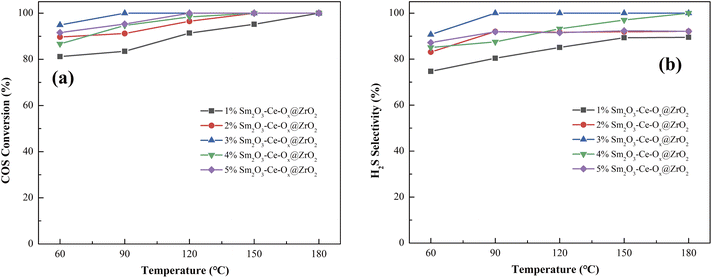 | ||
| Fig. 2 (a) COS conversion, (b) H2S selectivity of Sm-Ce-Ox@ZrO2 catalysts with different Sm contents. | ||
The dispersion state of the active component in the catalyst and the interaction between the active component and the carrier were greatly influenced by the calcination temperature, thus altering the catalytic activity of the catalyst.35,36 Fig. 3 showed the curves of the COS hydrolysis conversion and H2S selectivity for 3% Sm2O3-Ce-Ox@ZrO2 catalysts calcined at different temperatures. The results indicated that the optimal calcination temperature for the 3% Sm2O3-Ce-Ox@ZrO2 catalyst was 600 °C. When the calcination temperature was increased from 300 °C to 600 °C, the COS conversion and H2S selectivity of the 3% Sm2O3-Ce-Ox@ZrO2 catalyst both increased. The COS conversion increased from 71.1% to 94.9%, and the H2S selectivity increases from 71.7% to 90.7% at 60 °C. However, when the calcination temperature was 700 °C, the catalytic performance of the 3% Sm2O3-Ce-Ox@ZrO2 catalyst decreased. This might be attributed to the fact that excessively high calcination temperatures were unfavorable for the dispersion of the active component on the catalyst surface, while also leading to the destruction of the catalyst structure, thereby resulting in a decrease in the catalytic performance of the catalyst.37,38
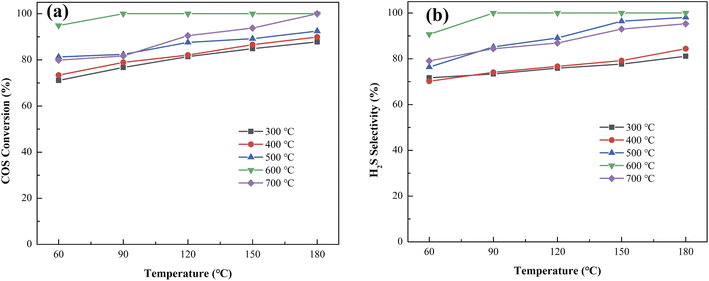 | ||
| Fig. 3 (a) COS conversion, (b) H2S selectivity of 3% Sm2O3-Ce-Ox@ZrO2 catalysts under different calcination temperatures. | ||
The calcination time of catalyst had an impact on both the COS conversion and H2S selectivity of the catalyst. Fig. 4 illustrated the catalytic performance and H2S selectivity of catalysts prepared with different calcination times at 600 °C. It can be observed that the hydrolysis activity of the catalyst first increased and then decreased with increasing calcination time. The optimal calcination time for the catalyst was 2 h, with a COS conversion of 94.9% at 60 °C and an H2S selectivity of 90.7%. Compared to a calcination time of 1 h, the hydrolysis efficiency increased by 25.6% and the H2S selectivity increased by 23.1%. The hydrolysis efficiency and H2S selectivity both remained at 100% after 90 °C. This was because a too short calcination time cannot form a Sm-Ce-Zr solid solution, reducing the redox properties of the catalyst and subsequently affecting its acidity and basicity. With further prolongation of the calcination time, the COS conversion decreased to 82% at 60 °C when the calcination time was 3 h, and further decreased to 78.4% when the calcination time was 4 h. An excessively long calcination time led to a decrease in COS conversion and a corresponding decrease in H2S selectivity, possibly due to the destruction of the pore structure caused by the prolonged calcination time, resulting in a decrease in hydrolysis activity.
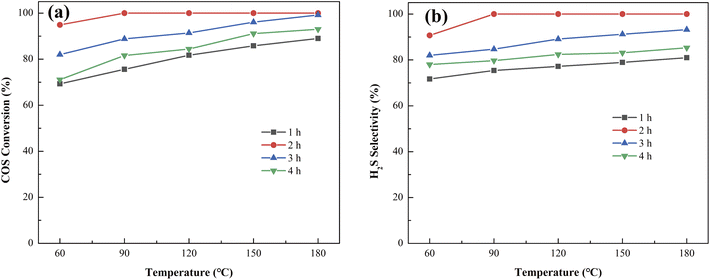 | ||
| Fig. 4 (a) COS conversion, (b) H2S selectivity and of 3% Sm2O3-Ce-Ox@ZrO2 catalysts under different calcination time. | ||
3.3 Efficiency of Sm-based catalysts
The stability of catalyst was one of the factors used to evaluate the performance of a catalyst.39,40 Fig. 5 illustrated the stability test results for different catalysts. From Fig. 1(a), it could be observed that the 3% Sm2O3-Ce-Ox@ZrO2 catalyst exhibited the best stability, maintaining 90% hydrolysis efficiency even after continuous testing for 20 h. This indicated that the addition of Sm enhanced the stability of the CeOx@ZrO2 catalyst. Based on this, the stability of the 3% Sm2O3-Ce-Ox@ZrO2 catalyst under different temperature conditions was investigated. Fig. 5(b) depicted the test curves for the 3% Sm2O3-Ce-Ox@ZrO2 catalyst at three different temperatures: 60 °C, 90 °C, and 120 °C. It can be seen that the COS conversion rate dropped to 90% after continuous testing for 7 h at 60 °C. This might be attributed to the condensation of H2O in the reaction gas, which covered the catalyst surface and reduced the hydrolysis activity. The catalyst maintained a 90% COS conversion for 30 h at 120 °C, which demonstrated the significant stability improvement of the catalyst with increased temperature.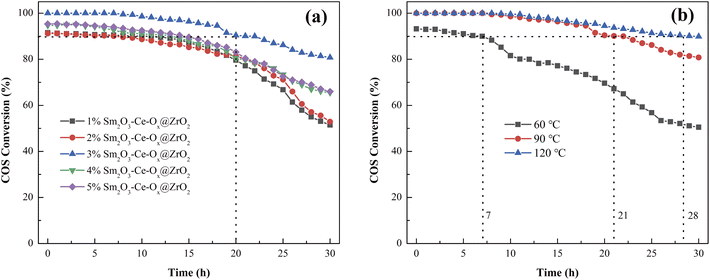 | ||
| Fig. 5 Stability of Sm2O3-Ce-Ox@ZrO2 catalyst: (a) different Sm contents, (b) different reaction temperature. | ||
The 3% Sm2O3-Ce-Ox@ZrO2 catalyst demonstrated superior catalytic performance in COS hydrolysis at lower temperatures (<90 °C) compared to both Al-based catalysts and activated carbon series catalysts (Table 1). This suggested that the addition of Sm2O3 effectively enhanced the basicity of the catalyst surface, increasing the number of active sites. As a result, the catalyst was able to promote the conversion of COS to H2S even at lower reaction temperatures, with the hydrolysis reaction playing a dominant role in the surface reaction.
3.4 Analysis of components
The X-ray diffraction patterns of different catalysts were presented in Fig. 6. From the graph, it can be observed that the catalysts exhibited diffraction peaks at 2θ = 17.3°, 24.1°, 28.2°, 31.5°, 34.1°, 35.2°, 38.5°, 40.8°, 46.2°, 50.5°, 54.2°, 55.6°, 59.9°, 63.1°, and 65.8°. These peaks corresponded to the crystal planes (001), (110), (−111), (111), (002), (−201), (120), (−112), (201), (−121), (221), (−311), (−203), (113), and (023) of ZrO2 (PDF-ICDD 37-1484).45,46 The diffraction peak at 2θ = 47.5° corresponded to the crystal plane (220) of CeO2 (PDF-ICDD 43-1002).47 However, characteristic diffraction peaks of Sm2O3 were not observed in the XRD pattern of the catalysts. This could be due to the low mass fraction of Sm in the catalyst or the highly dispersed or amorphous nature of Sm2O3 on the catalyst surface.3.5 Specific surface area analysis
The N2 adsorption and desorption curves, pore size distribution, and specific surface area of five catalyst groups were shown in Fig. 7 and Table 2. According to Table 2, when the doping amount was 3%, the specific surface area of the catalyst Sm2O3-Ce-Ox@ZrO2 increased from 27 m2 g−1 to 30 m2 g−1. The larger specific surface area increased the effective contact area between the reactants and the catalyst, which was beneficial for the adsorption and diffusion of reactant molecules on the catalyst surface. Meanwhile, the number of active sites of the catalyst were increased, thereby enhancing the hydrolysis activity of the catalyst. Although the catalysts with different Sm additions had different average pore diameters, the average pore diameters of each catalyst were still much larger than the molecular dynamic diameters of COS (0.34 nm) and H2O (0.27–0.32 nm), which suggests that COS and H2O can enter the internal pores of the catalysts for hydrolysis reactions.48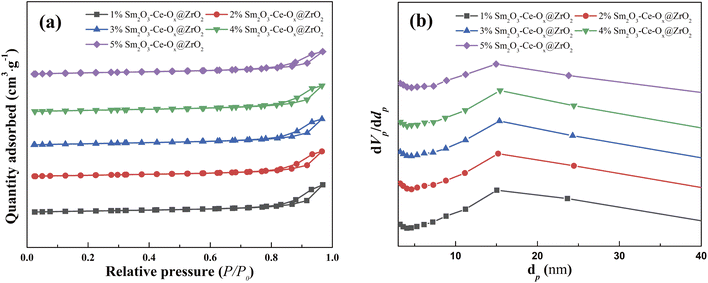 | ||
| Fig. 7 (a) N2 adsorption–desorption and (b) pore size distribution curves of Sm2O3-Ce-Ox@ZrO2 catalysts with different Sm contents. | ||
| Sample | BET surface area/(m2 g−1) | Pore volume/(cm3 g−1) | Average pore diameter/nm |
|---|---|---|---|
| 1% Sm2O3-Ce-Ox@ZrO2 | 27 | 0.10 | 15.6 |
| 2% Sm2O3-Ce-Ox@ZrO2 | 27 | 0.10 | 14.1 |
| 3% Sm2O3-Ce-Ox@ZrO2 | 31 | 0.10 | 13.2 |
| 4% Sm2O3-Ce-Ox@ZrO2 | 30 | 0.100 | 13.2 |
| 5% Sm2O3-Ce-Ox@ZrO2 | 33 | 0.09 | 10.9 |
3.6 Microscopic morphology analysis
SEM images of catalysts with different Sm contents were shown in Fig. 8. From Fig. 8(f), it can be observed that the catalysts composed of a series of irregular nanospheres, all of which exhibited irregular geometric shapes. Specifically, the 1% Sm2O3-Ce-Ox@ZrO2 catalysts agglomerated together to form a block-like structure with a relatively large volume, thus exhibiting a smaller specific surface area. With increasing Sm doping level, the block-like structure of the catalysts became smaller and more numerous, resulting in an increased specific surface area. When the Sm2O3 doping level reached 3%, the catalyst surface was enriched with a large number of spherical particles, and more obvious large pores were observed between the particles.49 When the Sm2O3 doping level reached 3%, the catalyst surface was enriched with a large number of spherical particles, and more obvious large pores were observed between the particles. The porous structure contributed to an increased specific surface area of the catalyst, which was also confirmed by BET test results. A larger specific surface area facilitated the adsorption and reaction of flue gas on the catalyst surface, leading to improved hydrolysis activity. However, the 5% Sm2O3-Ce-Ox@ZrO2 catalysts exhibited a significantly increased block-like volume and reduced quantity.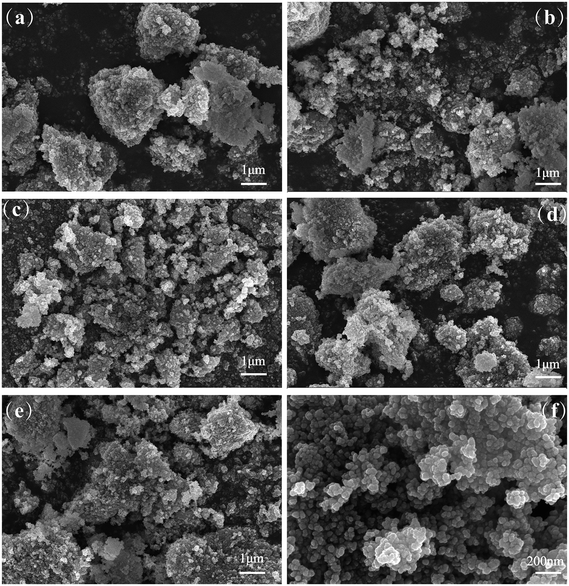 | ||
| Fig. 8 SEM images of Sm2O3-Ce-Ox@ZrO2 catalysts with Sm2O3 contents (a) 1%, (b) 2%, (c) 3%, (d) 4%, (e) 5%, (f) 5%–200 nm. | ||
3.7 Surface element composition analysis
The X-ray photoelectron spectroscopy (XPS) spectra of the Ce 3d, O 1s, and Zr 3d elements on different catalyst surfaces were depicted in Fig. 9. Fig. 9(a) illustrated the fitting curves of the Ce 3d peaks on different catalysts. The Ce 3d peaks can be divided into Ce3+ (902.7 eV and 885.1 eV) and Ce4+ (916.4 eV, 907.5 eV, 900.5 eV, 898.1 eV, 888.9 eV, 882.1 eV).50 It can be observed that the intensity of the Ce 3d peaks remained relatively unchanged as the doping level increases. This might be due to the fact that the relative concentration of Sm in the catalyst did not increase significantly in terms of overall content. Furthermore, according to Table 3, the proportion of Ce3+ in the catalyst gradually decreased with increasing Sm doping. This was because the relative content of Ce3+ decreased and some Sm was embedded in the Ce lattice, altering the structure and morphology of cerium oxide and forming a samarium–cerium solid solution, thereby enhancing the catalytic redox performance.51 The coexistence of Ce4+ and Ce3+ indicated a strong interaction between Ce and Sm, increasing the number of oxygen vacancies on the catalyst surface and promoting the redox cycling between Ce4+ and Ce3+. Consequently, the Sm doping can enhance the catalytic activity for hydrolysis.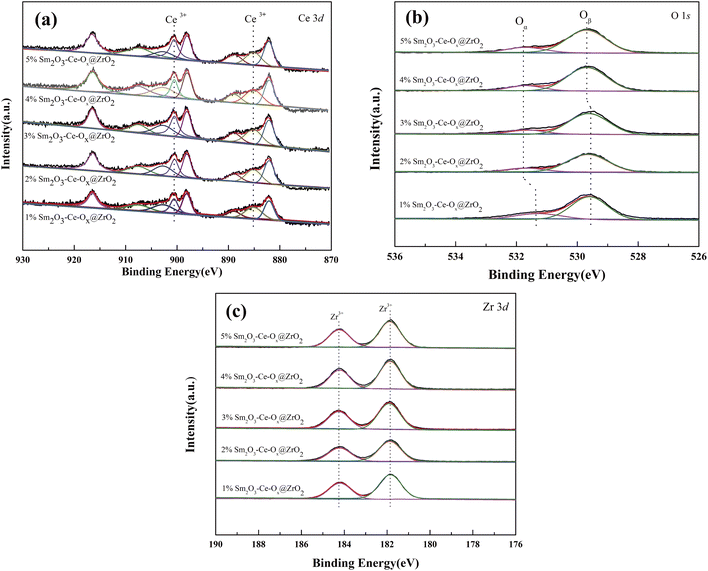 | ||
| Fig. 9 XPS profiles of Sm2O3-Ce-Ox@ZrO2 catalysts with different Sm contents (a) Ce 3d, (b) O 1s, (c) Zr 3d. | ||
| Sample | Ce3+/Cen+ | Oα/(Oα + Oβ) | Oβ/(Oα + Oβ) |
|---|---|---|---|
| 1% Sm2O3-Ce-Ox@ZrO2 | 0.257 | 0.249 | 0.751 |
| 2% Sm2O3-Ce-Ox@ZrO2 | 0.254 | 0.167 | 0.833 |
| 3% Sm2O3-Ce-Ox@ZrO2 | 0.244 | 0.151 | 0.849 |
| 4% Sm2O3-Ce-Ox@ZrO2 | 0.238 | 0.161 | 0.839 |
| 5% Sm2O3-Ce-Ox@ZrO2 | 0.185 | 0.183 | 0.817 |
Fig. 9(b) presented the peak fitting curves of different catalysts in the O 1s region. All catalysts exhibited peaks at 531.7 eV and 529.6 eV, with the peak around 531.7 eV attributed to chemisorbed surface oxygen (Oα) and the peak around 529.6 eV attributed to lattice oxygen (Oβ).52 With the introduction of Sm dopant, the O 1s spectral peaks shifted towards higher binding energies, indicating a strong interaction between Sm and O, which promoted catalytic activity. Chemisorbed surface oxygen was the most active oxygen species in catalytic reduction reactions, and studies had shown that oxygen adsorbed on the catalyst surface can oxidize intermediates generated during the hydrolysis of COS, leading to the formation of SO42−. A large amount of sulfate species can poison the active sites on the catalyst surface, thereby impeding the long-term progress of the hydrolysis reaction. As shown in Table 3, the concentration of chemisorbed surface oxygen initially decreased and then increased with an increase in Sm doping concentration. When the doping level was 3%, the catalyst exhibited the lowest concentration of chemisorbed surface oxygen and the highest concentration of lattice oxygen. This indicated that appropriate Sm doping facilitated the conversion of active chemisorbed surface oxygen into more stable lattice oxygen, thereby reducing the oxidation of intermediate products and maintaining the stability of the hydrolysis reaction. This also explained the significant improvement in low-temperature hydrolysis activity and superior stability of the catalyst after Sm doping.
Fig. 9(c) displayed the fitted curves of the Zr 3d peaks for different catalysts. The binding energy of approximately 181.8 eV corresponds to the Zr 3d5/2 peak, while the binding energy of approximately 184.2 eV corresponds to the Zr 3d3/2 peak. It can be observed from the graph that the intensity of the Zr 3d spectral peaks decreases with an increase in the amount of Sm doping, possibly due to a decrease in the relative content of Zr in the catalyst.
3.8 Surface acid and alkaline analysis
NH3-TPD is a commonly used characterization method to investigate the acidity of catalysts. The hydrolysis of COS was a base-catalyzed reaction, therefore, the stronger the acidity of the catalyst surface, the less favorable the adsorption of reactants on the catalyst surface. Fig. 10 showed the NH3-TPD test results of five groups of catalysts. All five groups of catalysts exhibited three NH3 desorption peaks within the temperature range of 100 °C, around 300 °C, and 600–700 °C, which can be attributed to weak acid sites, medium-strong acid sites, and strong acid sites.53 Among them, the desorption peak area of weak acid sites generally decreased with the increase of Sm doping amount. This indicated that the doping of Sm can effectively reduce the number of weak acid sites on the catalyst surface, making it easier for acidic reactants to adsorb on the catalyst surface, thereby improving the catalytic activity. The integrated peak area of medium-strong acid sites and strong acid sites was the smallest for the 3% Sm2O3-Ce-Ox@ZrO2 catalyst, indicating the lowest acidity on the catalyst surface. The 3% Sm2O3-Ce-Ox@ZrO2 catalyst had the lowest acid amount on the surface, which was beneficial for the adsorption and activation of COS molecules, thereby enhancing the catalytic activity of the catalyst for the hydrolysis of COS. Therefore, the 3% Sm2O3-Ce-Ox@ZrO2 catalyst exhibited the highest catalytic activity for COS hydrolysis.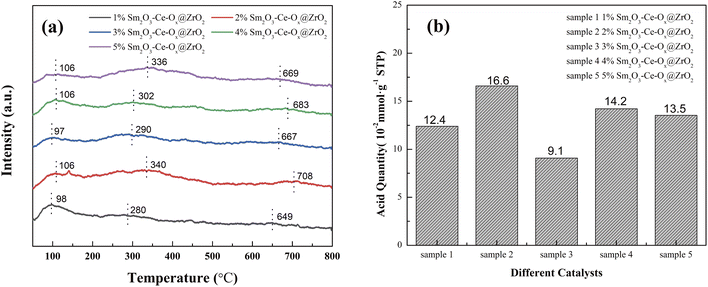 | ||
| Fig. 10 (a) NH3-TPD profiles and (b) acid quantity of Sm-Ce-Ox@ZrO2 catalysts with different Sm contents. | ||
The enhancement of catalyst surface alkalinity was beneficial to the adsorption of COS molecules on the catalyst surface, thereby improving the catalytic activity of hydrolysis reaction. As shown in Fig. 11, two desorption peaks were observed for all five catalyst groups at around 90 °C and 300 °C. The desorption peak around 90 °C was attributed to weak alkaline sites, which were manifested by hydroxyl groups (–OH) on the oxide surface. The desorption peak around 300 °C was attributed to medium-strong alkaline sites, which were manifested by lattice oxygen on the oxide surface. It was believed that the active centers for COS hydrolysis were mainly weak alkaline centers. As clearly seen from the figure, the desorption peak area of weak alkaline sites was greater than that of medium-strong sites for all samples, indicating that the number of weak alkaline centers in the catalyst was greater than the number of medium-strong alkaline centers, which also confirmed that weak alkaline centers play a major role in catalytic activity. In addition, the peak intensity of weak alkaline sites increased with the increase of Sm loading, indicating that the doping of Sm effectively increased the number of weak alkaline centers in the catalyst and improved the catalytic efficiency of hydrolysis. Therefore, it can be concluded that the alkaline sites on the catalyst surface played a key role in the hydrolysis of COS.
3.9 Redox performance analysis
In order to investigate the redox performance of catalysts, the oxidation–reduction properties of five catalyst groups were characterized using H2-TPR. The characterization test results of the five catalyst groups were shown in Fig. 12. All catalysts exhibited three hydrogen consumption peaks at around 380 °C, 510 °C and 660 °C. Firstly, the reduction peaks around 660 °C should be attributed to the bulk oxygen reductions of CeO2.54 Furthermore, the obvious shape changes reflected that the Sm doping had significant influence on the states of oxygen species. It is observed the shape changes of peaks around 380 and 510 °C, the peak coming to an end beyond 600 °C, which represented that a small amount of oxygen species on the surface and in the bulk could be reduced in the catalysts. In other words, appropriate amount of Sm doping was conductive to promoting the evolution to the abundance subsurface oxygen species from the surface or in the bulk. The intensity of the hydrogen consumption peak around 380 °C showed an initial increase followed by a decrease. This can be attributed to the reduction of Sm species with different dispersion states on the ZrO2 particles. When the Sm2O3 doping amount was 3%, the intensity of the hydrogen consumption peak reached its maximum. Additionally, the hydrogen consumption peak shifted to lower temperatures (from 514 °C to 503 °C). Notably, 3% Sm2O3-Ce-Ox@ZrO2 catalyst exhibited the lowest reduction peak temperature and consumed more amount of hydrogen, indicating that doping Sm improved the redox performance of the catalyst. This was also one of the reasons why the 3% Sm2O3-Ce-Ox@ZrO2 catalyst exhibited the best activity.4. Conclusions
This study involved the selection of rare earth metals Sm and Y, as well as alkali metals Na and K, for doping in the CeOx@ZrO2 catalyst system. Results showed that when the doping amount of Sm2O3 reached 3%, the COS conversion and H2S selectivity both reached 100% at 90 °C. The introduction of Sm2O3 led to an increase in the specific surface area of the catalyst and the enlargement of some of its pores. Consequently, the adsorption and activation of reactant molecules at low temperatures were affected. Additionally, the doping of Sm reduced the number of weak acid sites on the catalyst, while increasing the number of weak basic sites. This change proved beneficial for the adsorption and activation of COS molecules at low temperature. Proper doping of Sm facilitated the conversion of active surface chemisorbed oxygen into more stable lattice oxygen, thus decreasing the oxidation of intermediate products and maintaining the stability of the hydrolysis reaction.Author contributions
Jintao Yu: data curation, formal analysis, roles/writing – original draft, Yao Lu: data curation, formal analysis, roles/writing – original draft, Sheng Wang: data curation, Mutao Xu: data curation, formal analysis, Qijie Jin: methodology, investigation, funding acquisition, Chengzhang Zhu: methodology, investigation, Jisai Chen: supervision, validation, project administration, Haitao Xu: supervision, validation; funding acquisition, project administration.Conflicts of interest
The authors declare that there is no conflict of interests regarding the publication of this paper.Acknowledgements
This work is supported by the National Key Research and Development Program of China (2021YFB3500600 and 2021YFB3500605), Natural Science Foundation of Jiangsu Province (BK20220365), Key R&D Program of Jiangsu Province (BE2022142), Natural Science Foundation of the Jiangsu Higher Education Institutions of China (22KJB610002), Science and Technology Plan of Yangzhou (YZ2022030, YZ2023020), Science and Technology Plan of Nanjing (202201019), Nanjing Science and Technology Top Experts Gathering Plan.Notes and references
- P. F. Li, G. C. Wang, Y. Dong, Y. Q. Zhuo and Y. M. Fan, A review on desulfurization technologies of blast furnace gases, Curr. Pollut. Rep., 2022, 8, 189–200 CrossRef CAS.
- Y. F. Wang, L. Ding, H. M. Long, J. J. Xiao, L. X. Qian, H. T. Wang and C. B. Xu, Carbonyl sulfur removal from blast furnace gas: Recent progress, application status and future development, Chemosphere, 2022, 307, 136090 CrossRef CAS PubMed.
- X. Li, X. Q. Wang, L. L. Wang, P. Ning, Y. X. Ma, L. Zhong, Y. Wu and L. Yuan, Efficient removal of carbonyl sulfur and hydrogen sulfide from blast furnace gas by one-step catalytic process with modified activated carbon, Appl. Surf. Sci., 2022, 579, 152189 CrossRef CAS.
- K. Li, X. Song, T. T. Zhu, C. Wang, X. Sun, P. Ning and L. H. Tang, Mechanistic and kinetic study on the catalytic hydrolysis of COS in small clusters of sulfuric acid, Environ. Pollut., 2018, 232, 615–623 CrossRef CAS PubMed.
- J. Kim, J. Y. Do, K. Nahm, N.-K. Park, J. Chi, J.-P. Hong and M. Kang, Capturing ability for COS gas by a strong bridge bonding of a pair of potassium anchored on carbonate of activated carbon at low temperatures, Sep. Purif. Technol., 2019, 211, 421–429 CrossRef CAS.
- X. Sun, P. Ning, X. L. Tang, H. H. Yi, K. Li, D. He, X. M. Xu, B. Huang and R. Y. Lai, Simultaneous catalytic hydrolysis of carbonyl sulfide and carbon disulfide over Al2O3-K/CAC catalyst at low temperature, J. Energy Chem., 2014, 23, 221–226 CrossRef CAS.
- X. Y. Kong, J. Ding, L. Xie, J. H. Qin and J. G. Wang, Lanthanum-bismuth mixed oxide catalyst with improved activity for carbonyl sulfide hydrolysis, J. Environ. Chem. Eng., 2023, 11, 109830 CrossRef CAS.
- L. Wang, F. Zhang and J. M. Chen, Carbonyl sulfide derived from catalytic oxidation of carbon disulfide over atmospheric particles, Environ. Sci. Technol., 2001, 35, 2543–2547 CrossRef CAS PubMed.
- G. C. Lei, Y. Zheng, Y. N. Cao, L. J. Shen, S. P. Wang, S. J. Liang, Y. Y. Zhan and L. L. Jiang, Deactivation mechanism of COS hydrolysis over potassium modified alumina, Acta Phys.-Chim. Sin., 2023, 39, 2210038 Search PubMed.
- X. Song, X. Chen, L. N. Sun, K. Li, X. Sun, C. Wang and P. Ning, Synergistic effect of Fe2O3 and CuO on simultaneous catalytic hydrolysis of COS and CS2: Experimental and theoretical studies, Chem. Eng. J., 2020, 399, 125764 CrossRef CAS.
- X. Song, P. Ning, C. Wang, K. Li, L. H. Tang and X. Sun, Catalytic hydrolysis of COS over CeO2 (110) surface: A density functional theory study, Appl. Surf. Sci., 2017, 414, 345–352 CrossRef CAS.
- P. Ning, X. Song, K. Li, C. Wang, L. H. Tang and X. Sun, Catalytic hydrolysis of carbonyl sulphide and carbon disulphide over Fe2O3 cluster: Competitive adsorption and reaction mechanism, Sci. Rep., 2017, 7, 14452 CrossRef PubMed.
- Z. Wei, X. Zhang, F. L. Zhang, Q. Xie, S. Z. Zhao and Z. P. Hao, Boosting carbonyl sulfide catalytic hydrolysis performance over N-doped Mg-Al oxide derived from MgAl-layered double hydroxide, J. Hazard. Mater., 2021, 407, 124546 CrossRef CAS PubMed.
- C. M. Li, S. Y. Zhao, X. L. Yao, L. He, S. M. Xu, X. B. Shen and Z. L. Yao, The catalytic mechanism of intercalated chlorine anions as active basic sites in MgAl-layered double hydroxide for carbonyl sulfide hydrolysis, Environ. Sci. Pollut. Res., 2022, 29, 10605–10616 CrossRef CAS PubMed.
- E. C. Rupp, E. J. Granite and D. C. Stanko, Catalytic formation of carbonyl sulfide during warm gas clean-up of simulated coal-derived fuel gas with Pd/gamma-Al2O3 sorbents, Fuel, 2012, 92, 211–215 CrossRef CAS.
- P. Ning, K. Li, H. H. Yi, X. L. Tang, J. H. Peng, D. He, H. Y. Wang and S. Z. Zhao, Simultaneous catalytic hydrolysis of carbonyl sulfide and carbon disulfide over modified microwave coal-based active carbon catalysts at low temperature, J. Phys. Chem. C, 2012, 116, 17055–17062 CrossRef CAS.
- H. Y. Wang, H. H. Yi, X. L. Tang, P. Ning, L. Yu, D. He, S. Z. Zhao and K. Li, Catalytic hydrolysis of COS over calcined CoNiAl hydrotalcite-like compounds modified by cerium, Appl. Clay Sci., 2012, 70, 8–13 CrossRef CAS.
- A. Usmani, B. Tharat, A. Watwiangkham, N. Grisdanurak and S. Suthirakun, Enhancing kinetics of carbonyl sulfide hydrolysis using Pt-supported Al2O3 catalysts: first-principles-informed energetic span analysis, J. Phys. Chem. C, 2023, 127, 9002–9012 CrossRef CAS.
- E. Sasaoka, K. Taniguchi, A. Uddin, S. Hirano, S. Kasaoka and Y. Sakata, Characterization of reaction between ZnO and COS, Ind. Eng. Chem. Res., 1996, 35, 2389–2394 CrossRef CAS.
- X. Song, P. Ning, C. Wang, K. Li, L. H. Tang, X. Sun and H. T. Ruan, Research on the low temperature catalytic hydrolysis of COS and CS2 over walnut shell biochar modified by Fe-Cu mixed metal oxides and basic functional groups, Chem. Eng. J., 2017, 314, 418–433 CrossRef CAS.
- S. Z. Zhao, D. J. Kang, Y. P. Liu, Y. F. Wen, X. Z. Xie, H. H. Yi and X. L. Tang, Spontaneous formation of asymmetric oxygen vacancies in transition-metal-doped CeO2 nanorods with improved activity for carbonyl sulfide hydrolysis, ACS Catal., 2020, 10, 11739–11750 CrossRef CAS.
- A. Aboulayt, F. Mauge, P. E. Hoggan and J. C. Lavalley, Combined FTIR reactivity and quantum chemistry investigation of COS hydrolysis at metal oxide surfaces used to compare hydroxyl group basicity, Catal. Lett., 1996, 39, 213–218 CrossRef CAS.
- Y. H. Yue, X. P. Zhao, W. M. Hua and Z. Gao, Nanosized titania and zirconia as catalysts for hydrolysis of carbon disulfide, Appl. Catal., B, 2003, 46, 561–572 CrossRef CAS.
- J. West, B. P. Williams, N. Young, C. Rhodes and G. J. Hutchings, Low temperature hydrolysis of carbonyl sulfide using gamma-alumina catalysts, Catal. Lett., 2001, 74, 111–114 CrossRef CAS.
- O. Y. Gutierrez, C. Kaufmann and J. A. Lercher, Synthesis of methanethiol from carbonyl sulfide and carbon disulfide on (Co)K-promoted sulfide Mo/SiO2 catalysts, ACS Catal., 2011, 1, 1595–1603 CrossRef CAS.
- S. Z. Zhao, H. H. Yi, X. L. Tang and C. Y. Song, Low temperature hydrolysis of carbonyl sulfide using Zn-Al hydrotalcite-derived catalysts, Chem. Eng. J., 2013, 226, 161–165 CrossRef CAS.
- X. Li, X. Q. Wang, L. L. Wang, L. Yuan, Y. X. Ma, Y. B. Xie, Y. R. Xiong and P. Ning, Alkali-induced metal-based coconut shell biochar for efficient catalytic removal of H2S at a medium-high temperature in blast furnace gas with significantly enhanced S selectivity, Sep. Purif. Technol., 2023, 306, 122698 CrossRef CAS.
- J. N. Gu, J. X. Liang, S. J. Hu, Y. X. Xue, X. Min, M. M. Guo, X. F. Hu, J. P. Jia and T. H. Sun, Enhanced removal of COS from blast furnace gas via catalytic hydrolysis over Al2O3-based catalysts: Insight into the role of alkali metal hydroxide, Sep. Purif. Technol., 2022, 295, 121356 CrossRef CAS.
- P. T. Gao, Y. R. Li, Y. T. Lin, L. P. Chang and T. Y. Zhu, Promoting effect of Fe/La loading on gamma-Al2O3 catalyst for hydrolysis of carbonyl sulfur, Environ. Sci. Pollut. Res., 2022, 29, 84166–84179 CrossRef CAS PubMed.
- S. Z. Zhao, H. H. Yi, X. L. Tang, P. Ning, H. Y. Wang and D. He, Effect of Ce-doping on catalysts derived from hydrotalcite-like precursors for COS hydrolysis, J. Rare Earths, 2010, 28, 329–333 CrossRef.
- G. Y. Mu, Y. Zeng, Y. Zheng, Y. N. Cao, F. J. Liu, S. J. Liang, Y. Y. Zhan and L. L. Jiang, Oxygen vacancy defects engineering on Cu-doped Co3O4 for promoting effective COS hydrolysis, Green Energy Environ., 2023, 8, 831–841 CrossRef CAS.
- Y. Q. Zhang, Z. B. Xiao and J. X. Ma, Hydrolysis of carbonyl sulfide over rare earth oxysulfides, Appl. Catal., B, 2004, 48, 57–63 CrossRef CAS.
- X. Z. Li, Z. L. Hu, X. B. Zhao and X. W. Lu, Ce1-xSmxO2-delta-attapulgite nanocomposites: synthesis via simple microwave approach and investigation of its catalytic activity, J. Rare Earths, 2013, 31, 1157–1162 CrossRef CAS.
- P. F. Wang, J. Wang, J. Shi, X. Du, X. G. Hao, B. Tang, A. Abudula and G. Q. Guan, Low content of samarium doped CeO2 oxide catalysts derived from metal organic framework precursor for toluene oxidation, Mol. Catal., 2020, 492, 111027 CrossRef CAS.
- J. Ashok and S. Kawi, Steam reforming of toluene as a biomass tar model compound over CeO2 promoted Ni/CaO-Al2O3 catalytic systems, Int. J. Hydrogen Energy, 2013, 38, 13938–13949 CrossRef CAS.
- N. Wang, K. Shen, L. H. Huang, X. P. Yu, W. Z. Qian and W. Chu, Facile route for synthesizing ordered mesoporous Ni-Ce-Al oxide materials and their catalytic performance for methane dry reforming to hydrogen and syngas, ACS Catal., 2013, 3, 1638–1651 CrossRef CAS.
- J. Yang, S. Ren, T. S. Zhang, Z. H. Su, H. M. Long, M. Kong and L. Yao, Iron doped effects on active sites formation over activated carbon supported Mn-Ce oxide catalysts for low-temperature SCR of NO, Chem. Eng. J., 2020, 379, 122398 CrossRef.
- X. Fang, Y. J. Liu, Y. Cheng and W. L. Cen, Mechanism of Ce-modified birnessite-MnO2 in promoting SO2 poisoning resistance for low-temperature NH3-SCR, ACS Catal., 2021, 11, 4125–4135 CrossRef CAS.
- Z. M. Liu, J. Z. Zhu, J. H. Li, L. L. Ma and S. I. Woo, Novel Mn-Ce-Ti mixed-oxide catalyst for the selective catalytic reduction of NOx with NH3, ACS Appl. Mater. Interfaces, 2014, 6, 14500–14508 CrossRef CAS PubMed.
- X. B. Zhu, X. Gao, R. Qin, Y. X. Zeng, R. Y. Qu, C. H. Zheng and X. Tu, Plasma-catalytic removal of formaldehyde over Cu-Ce catalysts in a dielectric barrier discharge reactor, Appl. Catal., B, 2015, 170, 293–300 CrossRef.
- K. Nimthuphariyha, A. Usmani, N. Grisdanurak, E. Kanchanatip, M. Yan, S. Suthirakun and S. Tulaphol, Hydrolysis of carbonyl sulfide over modified Al2O3 by platinum and barium in a packed-bed reactor, Chem. Eng. Commun., 2021, 208, 539–548 CrossRef CAS.
- R. Cao, P. Ning, X. Q. Wang, L. L. Wang, Y. X. Ma, Y. B. Xie, H. Zhang and J. X. Qu, Low-temperature hydrolysis of carbonyl sulfide in blast furnace gas using Al2O3-based catalysts with high oxidation resistance, Fuel, 2022, 310, 122295 CrossRef CAS.
- H. H. Han, Z. H. Zhang and Y. L. Zhang, Research on the catalytic hydrolysis of COS by Fe-Cu/AC catalyst and its inactivation mechanism at low temperature, ChemistrySelect, 2022, 7, e202200194 CrossRef CAS.
- H. H. Yi, C. C. Du, X. D. Zhang, S. Z. Zhao, X. Z. Xie, L. L. Miao and X. L. Tang, Inhibition of CO in blast furnace flue gas on poisoning and deactivation of a Ni/Activated carbon catalyst in COS hydrolysis, Ind. Eng. Chem. Res., 2021, 60, 18183–18193 CrossRef CAS.
- P. Gao, F. Li, H. J. Zhan, N. Zhao, F. K. Xiao, W. Wei, L. S. Zhong, H. Wang and Y. H. Sun, Influence of Zr on the performance of Cu/Zn/Al/Zr catalysts via hydrotalcite-like precursors for CO2 hydrogenation to methanol, J. Catal., 2013, 298, 51–60 CrossRef CAS.
- C. Z. Sun, H. Liu, W. Chen, D. Z. Chen, S. H. Yu, A. N. Liu, L. Dong and S. Feng, Insights into the Sm/Zr co-doping effects on N2 selectivity and SO2 resistance of a MnOx-TiO2 catalyst for the NH3-SCR reaction, Chem. Eng. J., 2018, 347, 27–40 CrossRef CAS.
- N. Daelman, M. Capdevila-Cortada and N. Lopez, Dynamic charge and oxidation state of Pt/CeO2 single-atom catalysts, Nat. Mater., 2019, 18, 1215–1221 CrossRef CAS PubMed.
- N.-K. Park, J. Y. Park, T. J. Lee, J.-I. Baek and C. K. Ryu, Catalytic reduction of SO2 over Sn-Zr based catalysts for DSRP under high pressure, Catal. Today, 2011, 174, 46–53 CrossRef CAS.
- X. M. Sun, W. J. Huang, L. P. Ji, H. M. Xu, Z. Qu and N. Q. Yan, Establishing a self-supporting system of H2S production from SO2 with induced catalytic reduction process for mercury capture with super-large enrichment, Chem. Eng. J., 2023, 459, 141493 CrossRef CAS.
- J. L. Wang, J. G. Li, C. J. Jiang, P. Zhou, P. Y. Zhang and J. G. Yu, The effect of manganese vacancy in birnessite-type MnO2 on room-temperature oxidation of formaldehyde in air, Appl. Catal., B, 2017, 204, 147–155 CrossRef CAS.
- Y. Lu, Q. J. Jin, W. Y. Ji, C. Z. Zhu, M. T. Xu, Y. Y. Zhu and H. T. Xu, Resource utilization of high concentration SO2 for sulfur production over La-Ce-Ox@ZrO2 composite oxide catalyst, J. Rare Earths, 2023, 41(12), 1945–1952 CrossRef CAS.
- Q. J. Jin, M. M. Chen, X. J. Tao, B. X. Lu, J. Y. Shen, Y. S. Shen and Y. W. Zeng, Component synergistic catalysis of Ce-Sn-W-Ba-Ox/TiO2 in selective catalytic reduction of NO with ammonia, Appl. Surf. Sci., 2020, 512, 145757 CrossRef CAS.
- S. Das, J. M. Dowding, K. E. Klump, J. F. McGinnis, W. Self and S. Seal, Cerium oxide nanoparticles: applications and prospects in nanomedicine, Nanomedicine, 2013, 8, 1483–1508 CrossRef CAS PubMed.
- L. L. Zhao, Z. P. Zhang, Y. S. Li, X. S. Leng, T. R. Zhang, F. L. Yuan, X. Y. Niu and Y. J. Zhu, Synthesis of CeaMnOx hollow microsphere with hierarchical structure and its excellent catalytic performance for toluene combustion, Appl. Catal., B, 2019, 245, 502–512 CrossRef CAS.
Footnotes |
| † Electronic supplementary information (ESI) available. See DOI: https://doi.org/10.1039/d3ra06833a |
| ‡ Jintao Yu and Yao Lu contributed equally. |
| This journal is © The Royal Society of Chemistry 2024 |

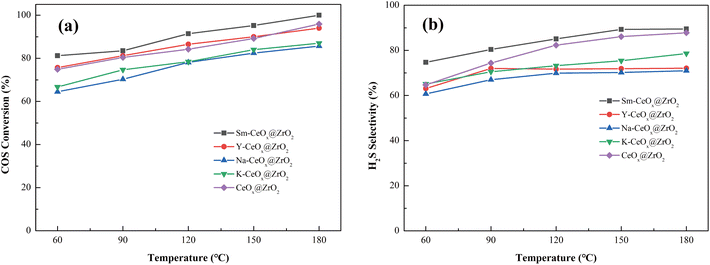
![[thin space (1/6-em)]](https://www.rsc.org/images/entities/char_2009.gif) 000
000